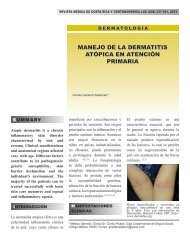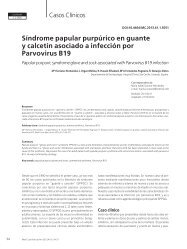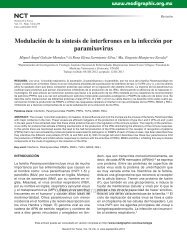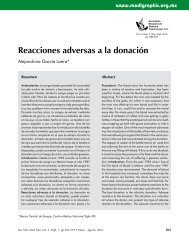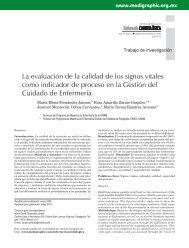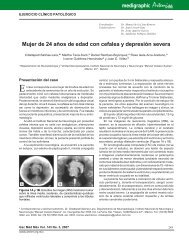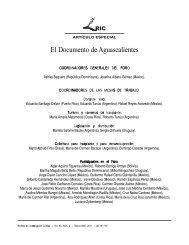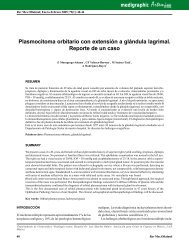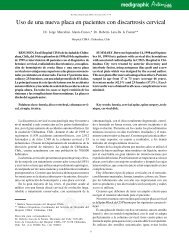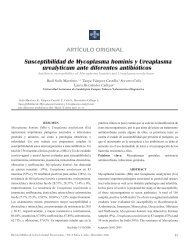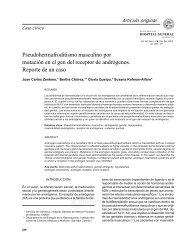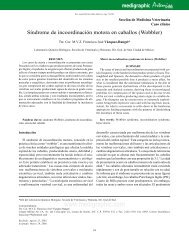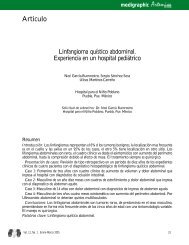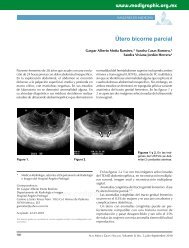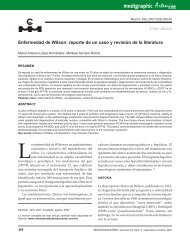Tratamiento de pacientes con coledocolitiasis - edigraphic.com
Tratamiento de pacientes con coledocolitiasis - edigraphic.com
Tratamiento de pacientes con coledocolitiasis - edigraphic.com
You also want an ePaper? Increase the reach of your titles
YUMPU automatically turns print PDFs into web optimized ePapers that Google loves.
Artículo original<br />
<strong>Tratamiento</strong> <strong>de</strong> <strong>pacientes</strong> <strong>con</strong> <strong>coledocolitiasis</strong><br />
Jorge Lucena Olavarrieta*<br />
Resumen<br />
Antece<strong>de</strong>ntes: Los cálculos coledocianos pue<strong>de</strong>n ser primarios o<br />
secundarios y los porcentajes <strong>de</strong> recurrencias varían.<br />
Objetivos: Evaluar los resultados <strong>de</strong>l tratamiento quirúrgico <strong>de</strong> la<br />
<strong>coledocolitiasis</strong>.<br />
Pacientes-métodos: Entre octubre 1984, y diciembre <strong>de</strong> 2004. Se<br />
estudiaron 280 <strong>pacientes</strong> que fueron divididos en tres grupos: “A”<br />
127 se les realizó coledocolitotomía y colocación <strong>de</strong> drenaje en T.<br />
En 98 se ejecutó la coledocoduo<strong>de</strong>nostomía, y en 55 se realizó la<br />
esfinterectomía endoscópica. Se <strong>de</strong>terminó el porcentaje <strong>de</strong> recurrencias<br />
<strong>de</strong> acuerdo a cada tipo <strong>de</strong> procedimiento. La coledocoduo<strong>de</strong>nostomía<br />
fue realizada en 98 enfermos para tratar <strong>de</strong> prevenir la<br />
recidiva.<br />
Resultados: La recurrencia se presentó en 14 <strong>pacientes</strong> <strong>con</strong> <strong>coledocolitiasis</strong>.<br />
El diámetro promedio <strong>de</strong>l <strong>con</strong>ducto <strong>com</strong>ún medido durante<br />
el tratamiento inicial fue mayor en las recurrencias; que en<br />
aquéllos sin recurrencia; P < 0.05. Se <strong>de</strong>tectaron cálculos biliares<br />
primarios en 32 <strong>de</strong> 165 <strong>pacientes</strong>, <strong>con</strong> litiasis recurrente (19.39%),<br />
igualmente este tipo <strong>de</strong> litiasis resultó más frecuente en los enfermos<br />
sin recurrencias, (P < 0.05).<br />
Conclusiones: Aunque, la coledocotomía y la colocación <strong>de</strong>l drenaje<br />
en T realizadas tanto por cirugía <strong>con</strong>vencional <strong>com</strong>o laparoscópica<br />
hasta el momento es un procedimiento <strong>com</strong>ún en el tratamiento <strong>de</strong> la<br />
<strong>coledocolitiasis</strong>, no previene la recurrencia <strong>de</strong> la enfermedad.<br />
Palabras clave: Coledocolitiasis, pronóstico, cálculos primarios,<br />
recurrencia, coledocolitotomía, tubo en T, coledocoduo<strong>de</strong>nostomía.<br />
INTRODUCCIÓN<br />
a <strong>coledocolitiasis</strong> pue<strong>de</strong> ser causada ya sea por cálculos<br />
en los <strong>con</strong>ductos biliares primarios que se originan en el<br />
<strong>con</strong>ducto biliar, o bien por cálculos en los <strong>con</strong>ductos biliares<br />
secundarios que se han <strong>de</strong>sprendido <strong>de</strong> la vesícula biliar, y las<br />
tasas <strong>de</strong> reaparición o recidiva varían <strong>de</strong>pendiendo <strong>de</strong>l tipo <strong>de</strong><br />
<strong>coledocolitiasis</strong>. 1,2 En los últimos años, a<strong>de</strong>más <strong>de</strong> los métodos<br />
<strong>de</strong> tratamiento no-operatorios, incluyendo la esfinterotomía endoscópica<br />
(ESE), la dilatación <strong>con</strong> globos en endoscopia papilar<br />
(DGEP), y la litotricia por ondas <strong>de</strong> shock extracorporal<br />
(LOSE); 3,4 las cirugías <strong>de</strong> mínima invasión, incluyendo la co-<br />
* Servicio <strong>de</strong> Cirugía General, Departamento <strong>de</strong> Cirugía. Hospital<br />
Universitario “Miguel Pérez Carreño”. Escuela <strong>de</strong> Medicina.<br />
Universidad Central <strong>de</strong> Venezuela, Caracas.<br />
Abstract<br />
<strong>edigraphic</strong>.<strong>com</strong><br />
Asociación Mexicana <strong>de</strong><br />
Cirugía Endoscópica, A.C.<br />
Vol.6 No.1 Ene.-Mar., 2005<br />
pp 33-38<br />
Background: Choledocholithiasis can be caused by either primary<br />
bile duct stones or by se<strong>con</strong>dary and the recurrences rates vary.<br />
Patients-methods: 280 outpatients were treated for choledocholithiasis<br />
from October 1984 to December 2004, and divi<strong>de</strong>d into 3<br />
groups: “A” 127 patients who had un<strong>de</strong>rgone choledocholithotomy<br />
and T-tube “B” 98 who had un<strong>de</strong>rgone choledochoduo<strong>de</strong>nostomy,<br />
and “C” 55 whose stones were removed by endoscopy. Choledochoduo<strong>de</strong>nostomy<br />
was performed in 98. Choledocholithiasis recurred<br />
in 14 of 280 the remaining 266 patients that showed no recurrence<br />
were <strong>com</strong>pared. All data are expressed as mean ± standard<br />
<strong>de</strong>viation. Analysis was performed with the χ 2 test and Stu<strong>de</strong>nt ‘ s.<br />
Value P = 0.05.<br />
Results: The diameter of the <strong>com</strong>mon bile duct was more dilated in<br />
patients with recurrent lithiasis than in patients without any recurrence<br />
P < 0.05. Furthermore, while primary bile duct stones were<br />
found in 9 of the 14 cases with recurrent, primary stones were found<br />
in only 32 of the 165 nonrecurrent patients, showing primary bile<br />
duct stones were also more <strong>com</strong>mon in recurrent patients (P < 0.05).<br />
Conclusion: Choledocholithotomy and T-tube drainage, is presently<br />
a <strong>com</strong>mon procedure for choledocholithiasis, this procedure will<br />
not necessarily prevent a recurrence.<br />
Key words: Choledocholithiasis, prognosis, primary bile duct stones,<br />
recurrence, choledocholithotomy, T tube drainage-choledochoduo<strong>de</strong>nostomy.<br />
ledocolitotomía laparoscópica, se están volviendo muy populares.<br />
5,6 Sin embargo, y <strong>de</strong>bido a que la tasa <strong>de</strong> recidiva luego<br />
<strong>de</strong> los tratamientos varía en un rango que va <strong>de</strong>s<strong>de</strong> un 6 a 4<br />
hasta el 18%, 7,8 sería <strong>de</strong>seable seleccionar métodos <strong>de</strong> tratamiento<br />
que no presenten recurrencia o recidiva.<br />
El objetivo <strong>de</strong> este trabajo fue <strong>de</strong>terminar el mejor método<br />
<strong>de</strong> tratamiento para evitar la recidiva en cada tipo <strong>de</strong> <strong>coledocolitiasis</strong>.<br />
PACIENTES Y MÉTODOS<br />
Se trataron mil noventa y seis <strong>pacientes</strong> (1,096) <strong>con</strong> <strong>coledocolitiasis</strong><br />
en el servicio <strong>de</strong> cirugía número uno <strong>de</strong>l Hospital<br />
Universitario Miguel Pérez Carreño, en Caracas, Venezuela,<br />
entre los meses <strong>de</strong> octubre <strong>de</strong> 1984 y diciembre <strong>de</strong><br />
2004. Ochocientos siete (807) <strong>pacientes</strong> presentando cole-<br />
33



